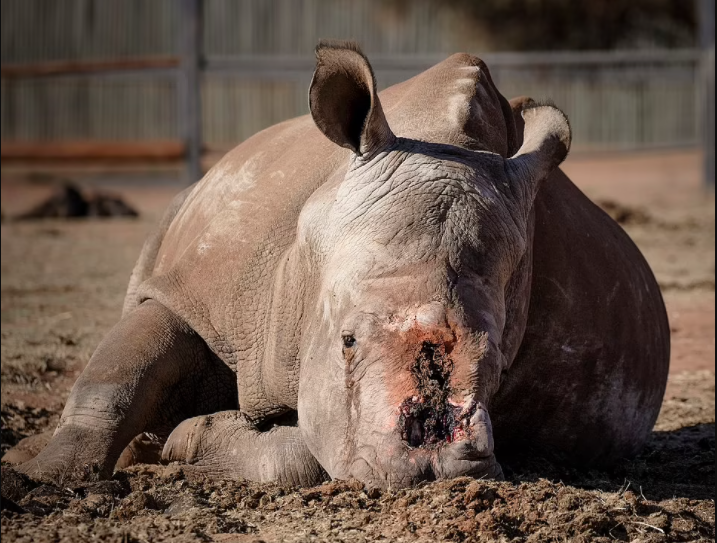Rhino poaching in South Africa remains a thorn in the flesh for the government and conservationists. On the morning of November 1, 2021, the country woke up to a sad tale. A teary male Southern White rhino lay still, helpless without a horn courtesy of poachers who struck a game reserve.
Gruesome photos of the 4.500lb rhino quickly circulated online. He lay on the ground with an open wound and a broken nasal bone. There are traces of dried-up tears on his face, an indication of the pain he endured.
The clearly heartless poachers removed some bones from the rhino’s skull and left him for dead. And the reserve’s owners left the injured and distraught rhino for two weeks to die.
He was not worth much to them without a horn but he would be rescued by Saving the Survivor’s reserve. Saving the Survivors is a charity reserve located in North West Province.

Poached Rhino. Photo/Daily Mail
It consists of a team of wildlife vets who save traumatic animals injured during poaching incidents.
But, this is one of the many cases of rhino poaching in South Africa.
Table of Contents
Why is Rhino Poaching in South Africa Rampant?
The fallacy that rhino horns contain medicinal value and a ready market contributes to the increasing poaching cases.
For instance, rhino poaching in South Africa in 2020 saw 394 rhino horns cut off. Yet, this was a 30% decrease from the 594 rhinos killed in 2019.
World-renowned Kruger National Park is a haven for poachers. Coupled with eased travel restrictions due to the COVID-19 pandemic in 2020, hundreds of rhinos were killed.
Jo Shaw, the Africa Rhino Lead for WWF International Network told Reuters that the Kruger landscape is problematic. Poachers invaded it in November last year through to 2021.
A report by the South African Forestry, Fisheries and Environment Ministry indicate there were 1573 poacher activities in Kruger last year.
International syndicates buying rhino horns work in cahoots with local poachers who execute the killings. They then smuggle the horns out of the country through established cartels in and out of South African borders.
Asia remains the largest market for wildlife trophies –including rhino horns and elephant tusks among others.
When Did Rhino Poaching in South Africa Start?
Rhino poaching started in 2008. Data by Save the Rhino, a non-profit conservationist organization shows 2014 and 2015 recorded the highest numbers of rhinos killed.
More than 2,500 rhinos lost their lives between 2014 and 2015 – the highest number since then. However, this number decreased but it is still high.

Rhino poaching in South Africa stats. Source/Save the Rhino.org
Ideally, data available suggest that poachers are after a rhino horn every 22 hours leading to a decrease in rhino population in South Africa. In particular, the rhino population at Kruger National Park is dwindling daily.
Poachers use tranquillizer shots to immobilize rhinos and hack off the horn. These animals die as a result of profuse bleeding after the horn is gone.
It adds to the stress of recovery for the last decade that rhino poaching in South Africa has been a menace. The situation is further worsened by long drought periods that end up killing rhinos due to hunger.
How Many Rhinos Are Left in South Africa?
South Africa has 16,000 rhinos left according to Frances Craigie the chief director of enforcement at the environmental ministry.
What is Being Done to Stop Rhino Poaching in South Africa?
The South African government devised and implemented various strategies in the last decade to tame poaching. One of the strategies has been reining in on local syndicates and criminal enterprises abetting poaching in South Africa.
The country also secured several arrests and convictions in the past but it is not enough to fully combat these crimes. Besides, the government budgetary allocation has more funds set aside for combating poaching in Kruger and other hotspots.
International donors are helping out too by pooling resources and increasing anti-poaching campaigns in the south. African countries are also working together and sharing information and investigations to combat wildlife trafficking.
The integrated approach to international collaboration has seen the Hawks, the Green Scorpions, DIRCO, INTERPOL, Customs, US Fish and Wildlife, US Home Land Security, and the UNODC working together on various aspects of wildlife trafficking.
A challenge, however, lies in consumer countries where demand for rhino horns is still very high. The black market remains vibrant too and a key motivator to local poachers.








